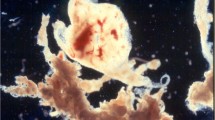Abstract
Purpose : To determine if careful specimen selection and washing of tissue from first trimester missed abortion products of conception specimens increases the sensitivity of routine cytogenetics in detecting aneuploidy.
Methods : Retrospective review of cytogenetics results from tissue from dilation and curettage for missed abortion in a university fertility practice between 1998 and 2001. A technique of careful selection and washing of the specimen was implemented in July 1999. Results from before (n = 15) and after (n = 41) this change were compared. Cytogenetics reports from other physicians using the same laboratory were used for comparison (n = 59).
Results : The percentage of 46XX results was significantly decreased in the test group when compared to historical and community controls: 29% vs. 73% and 56% respectively. The percentage of aneuploid results was significantly higher in the test group at 61% vs. 7% and 36% in the historical and community controls respectively.
Conclusion : Thorough separation and cleaning of villi prior to sending missed abortion specimens significantly increases sensitivity of conventional cytogenetics for detecting aneuploidy by decreasing maternal contamination.
Similar content being viewed by others
REFERENCES
Bell KA, Van Deerin PG, Haddad BR, Feinberg, RF: Cy-togenetic diagnosis of “normal 46XX” karyotypes in sponta-neous abortions frequently may be misleading. Fertil Steril 1999;72:334–341
Lomax B, Tang S, Separovic E, Phillips D, Hillard E, Thompson T, Kalousek DK: Comparative genomic hybridization in combination with flow cytometry improves results of cytogenetic analysis. Am J Hum Genet 2000;66:1516–1521
Jarrett KL, Michaels RC, Phelan MC, Vincent VA, Best RG: Microsatellite analysis reveals a high incidence of maternal cell contamination in 46XX products of conception consisting of villi or a combination of villi and membranous material.Am J Obstet Gynecol 2001;185:198–203
Stern JJ, Cerillo M, Dorfmann AD, Coulam CB, Gutierrez-Najar AJ: Frequency of abnormal karyotypes among abortuses from women with and without a history of recurrent spontaneous abortion. Fertil Steril 1996;65:250–253
Ogasawara M, Aoki K, Okada S, Suzumori K: Embryonic karyotype of abortuses in relation to the number of previous miscarriages. Fertil Steril 2000;73:300–304
Carp H, Toder V, Aviram A, Daniely M, Mashiach S, Barkai G: Karyotype of the abortus in recurrent miscarriage. Fertil Steril 2001;75:678–682
Ghazeeri GS, Kutteh WH: Immunologic testing and treatment in reproduction: Frequency assessment of practice patterns at assisted reproduction clinics in the USA and Australia. Hum Reprod 2001;16:2130–2135
Antiphospholipid syndrome. ACOG Educational and Practice Bulletin #244, February 1998
Author information
Authors and Affiliations
Rights and permissions
About this article
Cite this article
Lathi, R.B., Milki, A.A. Tissue Sampling Technique Affects Accuracy of Karyotype from Missed Abortions. J Assist Reprod Genet 19, 536–538 (2002). https://doi.org/10.1023/A:1020916003666
Issue Date:
DOI: https://doi.org/10.1023/A:1020916003666




